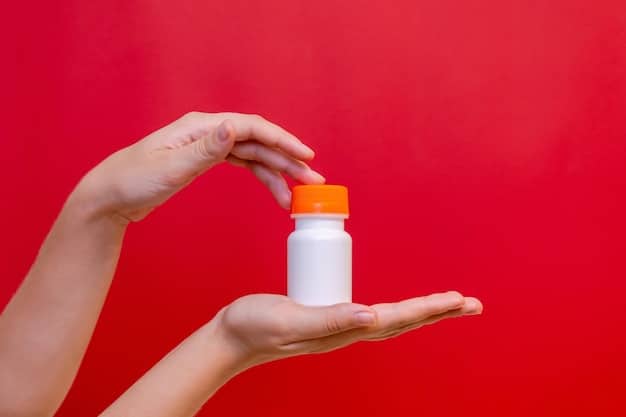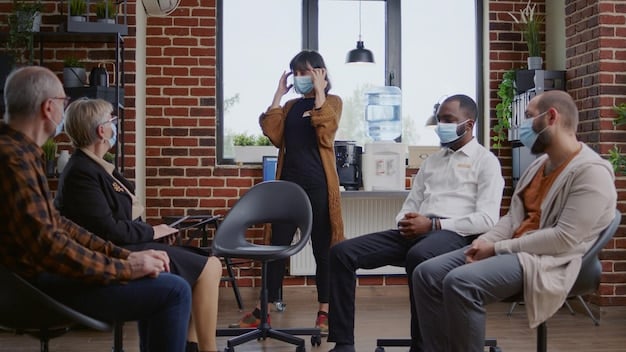Combating the Opioid Crisis: Public Health Strategies & 15% Overdose Reduction

Combating the Opioid Crisis: New Public Health Strategies Showing a 15% Reduction in Overdoses involves a multifaceted approach, incorporating prevention, treatment, and harm reduction strategies to mitigate the devastating impact of opioid addiction in communities across the US.
The opioid crisis continues to be a major public health concern in the United States. However, recent data suggests that combating the Opioid Crisis: New Public Health Strategies Showing a 15% Reduction in Overdoses is possible. This article explores innovative and effective public health initiatives that contribute to this positive trend.
Understanding these strategies is crucial for communities and policymakers seeking to address the opioid epidemic effectively. By examining the key components of these successful programs, we can gain insight into how to further reduce overdoses and improve public health outcomes.
Understanding the Scope of the Opioid Crisis
The opioid crisis has had a profound impact on communities across the United States, leading to significant health, social, and economic consequences. Recognizing the scale of the problem is the first step in combating the Opioid Crisis: New Public Health Strategies Showing a 15% Reduction in Overdoses.
The Devastating Statistics
Over the past two decades, the opioid crisis has claimed hundreds of thousands of lives. Overdose deaths involving opioids have surged, affecting individuals from all demographics and socioeconomic backgrounds. The crisis has placed immense strain on healthcare systems, emergency services, and community resources.
- In 2020, more than 93,000 people died from drug overdoses, with opioids being involved in over 75% of those deaths.
- The economic cost of the opioid crisis is estimated to be in the hundreds of billions of dollars annually, including healthcare costs, lost productivity, and criminal justice expenses.
- The crisis has also contributed to increased rates of infectious diseases, such as HIV and hepatitis C, due to injection drug use.
The opioid crisis is a complex problem with deep roots, including over-prescription of opioids, the rise of synthetic opioids like fentanyl, and underlying issues of addiction and mental health. Addressing the crisis requires a comprehensive and coordinated effort involving various stakeholders, including healthcare providers, policymakers, law enforcement, and community organizations.

Prevention Strategies: Reducing Opioid Use
Effective prevention strategies are essential for combating the Opioid Crisis: New Public Health Strategies Showing a 15% Reduction in Overdoses by reducing the demand for and misuse of opioids. These strategies target various stages of life and address the underlying factors that contribute to opioid addiction.
Education and Awareness Campaigns
Public awareness campaigns play a vital role in educating the public about the risks associated with opioid use and misuse. These campaigns aim to change attitudes and behaviors related to opioids, particularly among young people and other vulnerable populations.
For instance, school-based prevention programs can educate students about the dangers of drug use and provide them with the skills to resist peer pressure. Community-based campaigns can raise awareness about the risks of prescription opioid misuse and promote safe storage and disposal practices.
Prescription Drug Monitoring Programs (PDMPs)
Prescription Drug Monitoring Programs (PDMPs) are state-level electronic databases that track the prescribing and dispensing of controlled substances, including opioids. PDMPs enable healthcare providers to identify patients who are at risk of opioid misuse or diversion and to intervene appropriately. By providing real-time data on opioid prescribing patterns, PDMPs help prevent “doctor shopping” and reduce the overall supply of opioids in communities.
- PDMPs can help identify patients who are receiving multiple prescriptions from different providers, alerting healthcare providers to potential misuse or diversion.
- PDMPs can also help identify prescribers who are prescribing opioids at high rates, allowing for targeted interventions and education.
- By providing data on opioid prescribing patterns, PDMPs can help inform policy decisions and resource allocation.
Prevention strategies are a critical component of combating the Opioid Crisis: New Public Health Strategies Showing a 15% Reduction in Overdoses. By educating the public, monitoring prescription drug use, and promoting safe prescribing practices, we can reduce the demand for and misuse of opioids, ultimately preventing addiction and overdose deaths.
Expanding Access to Treatment for Opioid Addiction
Expanding access to treatment for opioid addiction is crucial for combating the Opioid Crisis: New Public Health Strategies Showing a 15% Reduction in Overdoses and saving lives. Treatment options include medication-assisted treatment (MAT), behavioral therapies, and support services.

Medication-Assisted Treatment (MAT)
Medication-assisted treatment (MAT) is the use of medications, such as buprenorphine and naltrexone, in combination with counseling and behavioral therapies to treat opioid addiction. MAT has been shown to be highly effective in reducing opioid cravings, preventing relapse, and improving overall health outcomes.
Buprenorphine is a partial opioid agonist that helps reduce opioid cravings and withdrawal symptoms without producing the same euphoric effects as other opioids. Naltrexone is an opioid antagonist that blocks the effects of opioids, preventing relapse. MAT is typically administered in outpatient settings, allowing patients to maintain their daily routines while receiving treatment.
Behavioral Therapies and Support Services
Behavioral therapies, such as cognitive-behavioral therapy (CBT) and motivational interviewing (MI), can help individuals with opioid addiction change their thoughts and behaviors related to drug use. CBT helps patients identify and challenge negative thoughts and behaviors, while MI helps patients explore their ambivalence about change and develop motivation to enter and stay in treatment.
- Support groups and peer support services provide individuals with opioid addiction with a sense of community and support.
- Case management services can help patients access housing, employment, and other resources that can support their recovery.
- Telehealth and mobile health technologies can expand access to treatment for individuals in rural or underserved areas.
By expanding access to MAT, behavioral therapies, and support services, we can help individuals with opioid addiction enter and stay in treatment, reducing their risk of overdose and improving their overall health and well-being. These efforts are critical for combating the Opioid Crisis: New Public Health Strategies Showing a 15% Reduction in Overdoses.
Harm Reduction Strategies: Minimizing the Consequences of Opioid Use
Harm reduction strategies aim to minimize the negative consequences associated with opioid use, such as overdose, infectious diseases, and other health problems. Harm reduction strategies do not condone or encourage drug use, but rather recognize that drug use exists and seek to reduce its harms. These efforts are significant for combating the Opioid Crisis: New Public Health Strategies Showing a 15% Reduction in Overdoses.
Naloxone Distribution
Naloxone is an opioid antagonist that can reverse the effects of an opioid overdose. Naloxone is safe and effective when administered promptly, and it can save lives. Naloxone distribution programs provide naloxone to individuals who are at risk of overdose, as well as their family members, friends, and other community members who may be in a position to respond to an overdose.
Naloxone distribution programs also provide training on how to recognize and respond to an opioid overdose, including how to administer naloxone. These programs are often implemented in collaboration with community organizations, healthcare providers, and law enforcement agencies.
Syringe Service Programs (SSPs)
Syringe service programs (SSPs) provide people who inject drugs with sterile syringes and other injection equipment, as well as education and counseling on safe injection practices. SSPs help reduce the spread of infectious diseases, such as HIV and hepatitis C, which are often transmitted through the sharing of needles.
SSPs also provide referrals to drug treatment, medical care, and other social services. SSPs are often controversial, but studies have shown that they are effective in reducing the spread of infectious diseases and do not increase drug use.
- Safe injection sites provide a safe and supervised environment for people to inject drugs, reducing the risk of overdose and other harms.
- Drug checking services allow people to test their drugs for fentanyl and other adulterants, helping them make informed decisions about their drug use.
- Education and outreach programs can help raise awareness about harm reduction strategies and reduce stigma associated with drug use.
Harm reduction strategies are an essential component of combating the Opioid Crisis: New Public Health Strategies Showing a 15% Reduction in Overdoses. By minimizing the harms associated with opioid use, we can save lives, reduce the spread of infectious diseases, and improve the health and well-being of individuals and communities.
Policy and Legislation: Supporting Public Health Initiatives
Policy and legislation play a critical role in supporting public health initiatives aimed at combating the Opioid Crisis: New Public Health Strategies Showing a 15% Reduction in Overdoses. These policies can help expand access to treatment, prevent opioid misuse, and reduce overdose deaths.
Expanding Access to Treatment
Federal and state policies can expand access to treatment for opioid addiction by increasing funding for treatment programs, reducing barriers to medication-assisted treatment (MAT), and expanding access to telehealth services. For example, the Affordable Care Act (ACA) expanded access to substance use disorder treatment by requiring most health insurance plans to cover these services.
Some states have also implemented policies that allow pharmacists to prescribe naloxone, making it more readily available to individuals at risk of overdose. Additionally, policies that support the integration of substance use disorder treatment into primary care settings can help reach more individuals in need of care.
Preventing Opioid Misuse
Prescription drug monitoring programs (PDMPs) are state-level electronic databases that track the prescribing and dispensing of controlled substances, including opioids. PDMPs can help identify patients who are at risk of opioid misuse or diversion and can alert healthcare providers to potential problems.
Policies that promote safe prescribing practices, such as guidelines for opioid prescribing and requirements for continuing medical education on pain management, can also help prevent opioid misuse. Additionally, policies that regulate the marketing and advertising of opioids can help reduce their demand.
- Policies that support harm reduction strategies, such as naloxone distribution and syringe service programs, can help reduce overdose deaths and the spread of infectious diseases.
- Policies that address the social and economic determinants of health, such as poverty, unemployment, and lack of access to education and housing, can help reduce the underlying factors that contribute to opioid addiction.
- Policies that promote evidence-based prevention and treatment strategies can help ensure that resources are used effectively.
By enacting policies and legislation that support public health initiatives, we can make significant progress in combating the Opioid Crisis: New Public Health Strategies Showing a 15% Reduction in Overdoses and creating healthier communities.
Community Engagement: A Collaborative Approach
Community engagement is essential for combating the Opioid Crisis: New Public Health Strategies Showing a 15% Reduction in Overdoses. A collaborative approach involving community organizations, healthcare providers, law enforcement, and residents is necessary to address the complex challenges posed by the opioid epidemic.
Building Trust and Partnerships
Effective community engagement requires building trust and partnerships between different stakeholders. Community organizations play a vital role in reaching individuals who may be hesitant to seek help from traditional healthcare providers or law enforcement agencies. These organizations can provide culturally competent services and build relationships with vulnerable populations.
Healthcare providers can partner with community organizations to offer outreach services, such as mobile clinics and community health fairs. Law enforcement agencies can work with community organizations to implement community policing strategies that focus on prevention and harm reduction rather than solely on enforcement.
- Community forums and town hall meetings can provide opportunities for residents to voice their concerns and share their experiences related to the opioid crisis.
- Community coalitions can bring together different stakeholders to develop and implement strategies to address the opioid crisis at the local level.
- Peer support groups can provide individuals with opioid addiction with a sense of community and support.
Community engagement is a critical component of combating the Opioid Crisis: New Public Health Strategies Showing a 15% Reduction in Overdoses. By working together, communities can develop and implement effective strategies to prevent opioid misuse, expand access to treatment, and reduce overdose deaths. This collaborative approach is essential for creating healthier and more resilient communities.
| Key Point | Brief Description |
|---|---|
| 💊 Prevention Strategies | Reducing opioid demand through education and monitoring programs. |
| ⚕️ Treatment Access | Medication-assisted treatment (MAT) and behavioral therapies. |
| 💉 Harm Reduction | Naloxone distribution and syringe service programs. |
| 🤝 Community Engagement | Collaborative efforts among organizations and residents. |
Frequently Asked Questions
Key strategies include prevention programs, expanded access to treatment, harm reduction measures like naloxone distribution, and policy changes supporting these initiatives.
MAT uses medications like buprenorphine and naltrexone to reduce cravings and withdrawal symptoms, combined with therapy for a comprehensive approach.
Harm reduction strategies, such as naloxone distribution and syringe service programs, aim to minimize the negative consequences associated with opioid use.
Community engagement fosters trust, builds partnerships, and allows for culturally competent services to reach vulnerable populations effectively.
Policy and legislation can expand access to treatment, prevent opioid misuse through prescription monitoring programs, and support harm reduction strategies at a systemic level.
Conclusion
Combating the Opioid Crisis: New Public Health Strategies Showing a 15% Reduction in Overdoses requires a comprehensive and collaborative approach. By implementing prevention strategies, expanding access to treatment, promoting harm reduction, and enacting supportive policies, communities can make significant progress in addressing the opioid epidemic.
Community engagement and partnerships are essential for building trust and ensuring that resources are used effectively. While challenges remain, the 15% reduction in overdose deaths demonstrates that meaningful change is possible through sustained and coordinated efforts.





